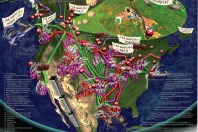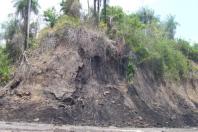December 17, 2014
There are zombies in the oil fields.
After crude prices dropped 49 percent in six months, oil projects planned for next year are the undead -- still standing upright, but with little hope of a productive future. These zombie projects proliferate in expensive Arctic oil, deepwater-drilling regions and tar sands from Canada to Venezuela.
In a stunning analysis this week, Goldman Sachs found almost $1 trillion in investments in future oil projects at risk. They looked at 400 of the world’s largest new oil and gas fields -- excluding U.S. shale -- and found projects representing $930 billion of future investment that are no longer profitable with Brent crude at $70. In the U.S., the shale-oil party isn’t over yet, but zombies are beginning to crash it.
The chart below shows the break-even points for the top 400 new fields and how much future oil production they represent. Less than a third of projects are still profitable with oil at $70. If the unprofitable projects were scuttled, it would mean a loss of 7.5 million barrels per day of production in 2025, equivalent to 8 percent of current global demand.
How Profitable Is $70 Oil?
Making matters worse, Brent prices this week dipped further, below $60 a barrel for the first time in more than five years. Why? The U.S. shale-oil boom has flooded the market with new supply, global demand led by China has softened, and the Saudis have so far refused to curb production to prop up prices.
It’s not clear yet how far OPEC is willing to let prices slide. The U.A.E.’s energy minister said on Dec. 14 that OPEC wouldn’t trim production even if prices fall to $40 a barrel. An all-out price war could take up to 18 months to play out, said Kevin Book, managing director at ClearView Energy Partners LLC, a financial research group in Washington.
If cheap oil continues, it could be a major setback for the U.S. oil boom. In the chart below, ClearView shows projected oil production at four major U.S. shale formations: Bakken, Eagle Ford, Permian and Niobrara. The dark blue line shows where oil production levels were headed before the price drop. The light blue line shows a new reality, with production growth dropping 40 percent.
Even $75 Oil Crashes the Shale-Oil Party
The Goldman tally takes the long view of project finance as it plays out over the next decade or more. But the initial impact of low prices may be swift. Next year alone, oil and gas companies will make final investment decisions on 800 projects worth $500 billion, said Lars Eirik Nicolaisen, a partner at Oslo-based Rystad Energy. If the price of oil averages $70 in 2015, he wrote in an email, $150 billion will be pulled from oil and gas exploration around the world.
An oil price of $65 dollars a barrel next year would trigger the biggest drop in project finance in decades, according to a Sanford C. Bernstein analysis last week.
A pause in exploration and development may sound like good news for investors concerned about climate change. A vocal minority have been warning for years that potentially trillions of dollars of untapped assets may become stranded due to climate policies and improved energy efficiency. The challenges faced by oil developers today may provide a small sense of what's to come.
However, these glut-driven prices can’t stay low forever. Oil production hasn’t slowed yet, but as zombie projects go unfunded, it will. This is how the boom-bust-boom of the oil market goes: prices fall, then production follows, pushing prices higher again. The longer this standoff goes, the more zombies will languish and the sharper the rebounding price spike may be.
http://www.bloomberg.com/news/articles/2014-12-18/bankers-see-1-trillion-of-investments-stranded-in-the-oil-fields


